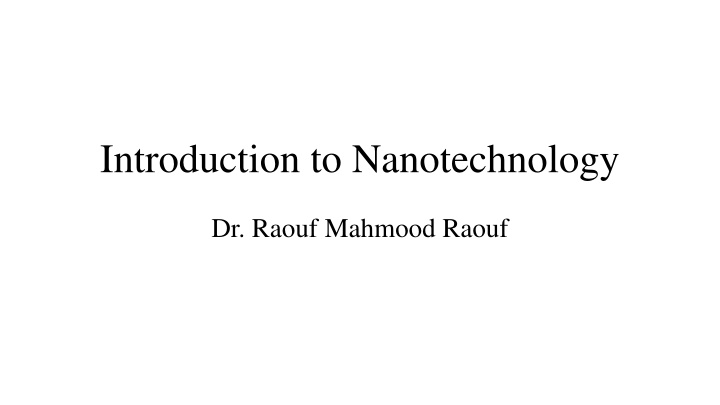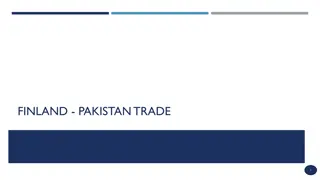
Understanding Nanotechnology and Its Applications
Explore the world of nanotechnology with Dr. Raouf Mahmood Raouf as he delves into the synthesis of nano-particles, processing of nano materials, and their diverse applications across various fields like ceramics, electronics, bionics, photonics, and bio-ceramics. Discover how nanotechnology enables the creation of materials with enhanced properties and find out the scope of applications in different industries.
Download Presentation

Please find below an Image/Link to download the presentation.
The content on the website is provided AS IS for your information and personal use only. It may not be sold, licensed, or shared on other websites without obtaining consent from the author. If you encounter any issues during the download, it is possible that the publisher has removed the file from their server.
You are allowed to download the files provided on this website for personal or commercial use, subject to the condition that they are used lawfully. All files are the property of their respective owners.
The content on the website is provided AS IS for your information and personal use only. It may not be sold, licensed, or shared on other websites without obtaining consent from the author.
E N D
Presentation Transcript
Introduction to Nanotechnology Dr. Raouf Mahmood Raouf 1
What is Nano Nano-technology is an advanced technology, which deals with the synthesis of nano-particles, processing of the nano materials and their applications. Normally, if the particle sizes are in the 1-100 nm ranges, they are generally called nano-particles or materials. In order to give an idea on this sizerange, let us look at some dimensions : 1 nm = 10 = 10 9 meter and 1 m (i.e., 1 micron) = 10 4 cm = 1000 nm. For oxide materials, the diameter of one oxygen ion is about 1.4 . So, seven oxygen ions will make about 10 or 1 nm, i.e., the lower side of the nano range. On the higher side, about 700 oxygen ions in a spatial dimension will make the so-called limit of the nano range of materials. 2
Why Nano Technology In the materials world, particularly in ceramics, the trend is always to prepare finer powder for the ultimate processing and better sintering to achieve dense materials with dense fine-grained microstructure of the particulates with better and useful properties for various applications. The fineness can reach up to a molecular level (1 nm 100 nm), by special processing techniques. More is the fineness, more is the surface area, which increases the reactivity of the material. So, the densification or consolidation occurs very well at lower temperature than that of conventional ceramic systems, which is finally cost- effective and also improves the properties of materials like abrasion resistance, corrosion resistance, mechanical properties, electrical properties, optical properties, magnetic properties, and a host of other properties for various useful applications in diverse fields. 3
Scope of Applications The deviations from the bulk phase diagram may be exploited to form certain compositions of alloys that are otherwise unstable in the bulk form. In addition, the thermal stability of interfacial regions is typically less than that of the bulk material : thus the nano-phase materials are often sintered or undergo phase transformation at temperatures below those of the bulk material. This is a characteristic which has numerous applications to material processing. By improving material properties, we are able to find the applications as varied as semiconductor electronics, sensors, special polymers, magnetics, advanced ceramics, and membranes. We need to improve our current understanding of particle size control and methodologies for several classes of Nano phase materials and address the issues of their characterization. We should also explore the fields in which there are foreseeable application of nano-phase materials to long standing materials problems, since these issues have to be tackled by us. As said earlier, there is a scope of wider applications in different fields such as : 4
Scope of Applications (a)Electronics in terms of Thin Films, Electronic Devices like MOSFET, JFET and in Electrical Ceramics, (b) Bionics, 5
Scope of Applications (a)Photonics, (b) Bio-Ceramics, 6
Scope of Applications (a) Bio-Technology, (b)Medical Instrumentation (c) etc. 7
Definition Nanotechnology is the understanding and control of matter at dimensions of roughly 1 to 100 nanometers, where unique phenomena enable novel applications, nanotechnology involves imaging, measuring, modeling, and manipulating matter at this length scale. 8 7
How do properties change at the Nano scale? When particle sizes of solid matter in the visible scale are compared to what can be seen in a regular optical microscope, there is little difference in the properties of the particles. But when particles are created with dimensions of about 1 100 nanometres (where the particles can be seen only with powerful specialized microscopes), the materials properties change significantly from those at larger scales. This is the size scale where so-called quantum effects rule the behaviour and properties of particles. Properties of materials are size- dependent in this scale range. Thus, when particle size is made to be Nano scale, properties such as melting point, fluorescence, electrical conductivity, magnetic permeability, and chemical reactivity change as a function of the size of the particle. 9
How do properties change at the Nano scale? Nanoscale gold illustrates the unique properties that occur at the nanoscale. Nanoscale gold particles are not the yellow color with which we are familiar; nanoscale gold can appear red or purple. At the nanoscale, the motion of the gold s electrons is confined. Because this movement is restricted, gold nanoparticles react differently with light compared to larger-scale gold particles. Their size and optical properties can be put to practical use: nanoscale gold particles selectively accumulate in tumors, where they can enable both precise imaging and targeted laser destruction of the tumor by means that avoid harming healthy cells. 10
How do properties change at the Nano scale? A fascinating and powerful result of the quantum effects of the nanoscale is the concept of tunability of properties. That is, by changing the size of the particle, a scientist can literally fine- tune a material property of interest (e.g., changing fluorescence color; in turn, the fluorescence color of a particle can be used to identify the particle, and various materials can be labeled with fluorescent markers for various purposes). Another potent quantum effect of the nanoscale is known as tunneling which is a phenomenon that enables the scanning tunneling microscope and flash memory for computing. 11
References Murday, James F. (2005). Nanotechnology: Hype and Hope in Aerospace Applications. Advanced Materials and Processes. Vol. 163, Issue 12, P. 21. Rappaport, Tatiana Gabriela (2006). Semiconductors: Nanostructures and applications in spintronics and quantum computation. Vol. 809 issue 1, p.326. Wong, H.S. Philip (2006, March). Nanoelectronics Opportunities and Challenges. International Journal of High Speed Electronics and Systems. Vol. 16, Issue 1, p. 83, 12p. Yamaguchi, Tomohiko; Epstein, Irving; Shimomura, Masatsugu; & Kunitake, Toyoki (2005, December). Vol. 15, Issue 4, p. N, 3 p. 12






















